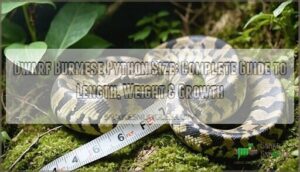This site is supported by our readers. We may earn a commission, at no cost to you, if you purchase through links.

Females generally outgrow males by 1-2 feet, reaching adult size within 3-4 years from their 22-inch hatchling start. However, here’s the catch—hybrids mixed with mainland genetics can surprise you by growing 7-10 feet, so genetic purity matters if you’re counting on that compact size.
These snakes pack all the visual appeal of their giant relatives into a space-friendly package, though proper permits remain nearly impossible to obtain.
Table Of Contents
Key Takeaways
- You’ll get a manageable 4-6 foot snake weighing 4-15 pounds when fully grown, making them far more practical than mainland Burmese pythons that exceed 20 feet.
- You need to verify genetic purity since hybrids mixed with mainland genetics can surprise you by growing 7-10 feet instead of staying compact.
- You’ll see your dwarf python reach adult size within 3-4 years from its 22-inch hatchling start, with females typically outgrowing males by 1-2 feet.
- You’ll face significant legal restrictions since federal law prohibits interstate commerce and most states ban possession entirely, making permits nearly impossible to obtain.
Dwarf Burmese Python Size Overview
Dwarf Burmese pythons reach a manageable adult size of 4-6 feet, making them considerably smaller than their mainland cousins that can exceed 20 feet.
These compact serpents generally weigh between 4-15 pounds when fully grown, with females generally outgrowing males by 1-2 feet in length.
Average Adult Length and Weight
When you’re looking at typical adult size for dwarf Burmese pythons, females reach 5.5-6 feet while adult male dwarf Burmese pythons stay around 4-4.5 feet. Weight variations range from 4-15 pounds, with influencing factors like genetics and locality affecting final dimensions.
These pythons are considered a smaller snake species compared to their mainland counterparts. Measurement accuracy matters since these dwarf Burmese differ substantially from mainland Burmese python giants, making health implications easier to manage.
Range of Sizes in Captivity and Wild
You’ll notice captive size variation among dwarf Burmese pythons differs from wild populations. Environmental impact shapes growth patterns, with wild specimens usually staying smaller due to natural selection pressures.
Island gigantism occasionally produces larger individuals, though adult male dwarf Burmese pythons rarely exceed their genetic limits. Captive specimens may reach upper size ranges with consistent feeding.
Comparison to Mainland Burmese Pythons
Understanding size differences between dwarf Burmese pythons and their mainland cousins reveals a dramatic contrast. Your dwarf Burmese python length tops out around 8.2 feet, while mainland Burmese Python Traits include reaching 19+ feet. Mainland females dwarf their island relatives by 200+ pounds. These snakes are also excellent swimmers in their native habitats.
This coloration and build difference stems from habitat overlap limitations on Indonesian islands, creating distinct care differences and conservation concerns.
Physical and Genetic Characteristics
You’ll notice dwarf Burmese pythons don’t just differ in size from their mainland cousins, they’re built differently too. Their genetics control both their compact length but also their slimmer build, more pronounced markings, and the clear size differences you’ll see between males and females.
Slimmer Build and Distinct Markings
You’ll notice dwarf Burmese pythons pack more visual punch than their mainland cousins. These snakes sport lighter coloration with sharper contrast between their brown blotches and cream backgrounds. Their scale morphology creates more defined pattern uniqueness that makes identification easier.
- Pattern Uniqueness: Each dwarf Burmese python displays distinct markings genetics that create individual "fingerprints" unlike any other snake
- Coloration Detail: Captive variation often intensifies the natural lighter coloration, making these pythons stunning display animals
- Scale Morphology: The slimmer build emphasizes their intricate markings, creating a more elegant appearance than bulky mainland pythons
Sexual Dimorphism in Size
Among dwarf Burmese pythons, females display a clear Female Size Advantage, generally reaching 5.5-6 feet while males max out around 4-4.5 feet. This Male Size Variation creates notable Captive Dimorphism Trends, with females often twice the weight of males.
Wild Dimorphism Studies confirm this pattern across Indonesian populations, making sex determination easier for breeders.
Genetic Influence on Size Variation
Your dwarf Burmese python’s small stature isn’t just luck—it’s genetics at work. Genetic predisposition controls size through specific gene expression patterns inherited from insular populations.
Selective breeding maintains these heritability factors, while mutation impact remains minimal. Pure dwarf Burmese pythons carry distinct genetic markers that regulate growth, ensuring consistent coloration and compact dimensions across generations.
Growth Rate and Maturity
You’ll find dwarf Burmese pythons reach maturity much faster than you might expect, generally achieving adult size within 3-4 years.
Understanding their growth patterns helps you provide proper care and set realistic expectations for your snake’s development timeline.
Hatchling Size and Early Growth
Your dwarf python hatchling will emerge at about 22 inches, sporting vibrant coloration that’ll catch your eye immediately. These little ones hit the ground running with impressive early growth spurts during their first year.
- Initial Hatchling Size: That adorable 22-inch package packs serious growing potential
- Early Shedding: Watch for frequent sheds as they rapidly outgrow their skin
- First Meals: Success with initial feedings sets the foundation for healthy development
Proper juvenile care during this critical period ensures your small stature snake develops correctly.
Typical Age to Reach Adult Size
Your dwarf Burmese python reaches adult size by 3-4 years in captivity, though wild maturity may vary. Growth timeline depends on several maturity factors including genetics and environment. Here’s what you’ll generally see:
| Age | Length Range | Growth Stage |
|---|---|---|
| 0-1 year | 22-36 inches | Rapid growth |
| 1-2 years | 3-4 feet | Active growing |
| 2-3 years | 4-5 feet | Approaching maturity |
| 3-4 years | 5-6 feet | Adult size reached |
| 4+ years | Full adult | Size stabilizes |
Most dwarfs reach their dwarfed adult proportions faster than their mainland cousins, making them manageable pets sooner than expected.
Effects of Diet and Feeding Practices
Power feeding dramatically affects your dwarf Burmese python’s growth trajectory. Strategic feeding choices determine whether you’ll have a compact companion or a dwarfed giant with health complications.
Key feeding factors that influence size:
- Feeding Frequency: Adults thrive on meals every 4–6 weeks, while juveniles need food every 2–3 weeks to prevent obesity risks.
- Prey Size: Choose items matching your snake’s widest diameter, usually 10–30% of body weight for growth acceleration.
- Nutritional Variety: Mixed diets prevent nutritional deficiencies that can stunt development and dull distinctive markings.
- Power Feeding Risks: Frequent meals create larger snakes but increase metabolic disorders and organ strain.
- Fasting Periods: Strategic 4-month fasts support healthy metabolism and prevent excessive weight gain.
Your feeding schedule directly impacts whether your dwarf reaches its genetic potential or exceeds healthy size limits.
Hybridization and Size Variability
You’ll encounter pure dwarf Burmese pythons and hybrids mixed with mainland genetics in today’s reptile market.
These breeding crosses can produce snakes that exceed typical dwarf size limits, reaching 7-10 feet instead of the expected 4-6 foot range.
Hybrids Vs. Pure Dwarf Burmese Pythons
Hybrid identification presents challenges since half-dwarf Burmese pythons reach 5-10 feet, exceeding pure dwarf sizes of 4-8 feet.
Pure dwarfs show consistent genetic purity with finer markings and slimmer builds.
Breeding ethics matter because hybrids display unpredictable "mutt genetics," affecting conservation status.
Morph influence varies greatly in hybrids compared to predictable dwarf definition standards that true dwarfed specimens maintain.
Impact of Breeding Choices on Size
Your breeding decisions directly shape your dwarf Burmese python’s adult size. Selective breeding for smaller traits strengthens the dwarfing genes, while outcrossing to mainland lines increases size potential.
Lineage influence matters – choosing parents from consistently small bloodlines maintains genetic diversity without sacrificing the compact size that makes these dwarfs special.
Rarity and Demand for Pure Dwarfs
Finding pure dwarf genetics has become increasingly challenging for enthusiasts. Captive breeding challenges include limited bloodlines and conservation concerns about wild populations.
Market price factors reflect this scarcity—authentic dwarfs command premium prices. Ethical sourcing remains paramount as demand outstrips supply.
Many advertised "dwarfs" lack proper documentation, making verification difficult for buyers seeking genuine specimens.
Considerations for Potential Owners
You’ll need to think about several practical factors before deciding if a dwarf Burmese python fits your situation. Space requirements, legal restrictions in your area, and the snake’s manageable size compared to mainland Burmese pythons all play important roles in making this decision.
Space and Enclosure Requirements
Despite their dwarfed nature, these pythons need adequate space to thrive. Your enclosure size should accommodate their adult length plus proper environmental controls.
- 40-gallon minimum for adults, with secure ventilation and sturdy locks
- Temperature gradient from 78-88°F with basking spot and consistent heating needs
- Humidity levels at 50-60% using appropriate substrate choice like cypress mulch
Add enrichment ideas like hiding spots and climbing branches to keep your dwarf python engaged.
Legal Restrictions and Availability
Before purchasing, you’ll face significant legal hurdles. Federal law prohibits interstate commerce of Burmese pythons under the Lacey Act, while most states ban possession entirely.
Federal law prohibits interstate commerce of Burmese pythons under the Lacey Act while most states ban possession entirely
Permitting requirements are extremely restrictive, often limited to research institutions. Captive breeding operations are rare due to conservation status restrictions, making ethical sourcing nearly impossible.
The American English legal framework effectively eliminates availability.
Suitability as Pets Based on Size
At manageable sizes, dwarf Burmese pythons make better pets than their giant cousins. Their compact nature offers several advantages:
- Enclosure Size: Requires 4x2x2 feet minimum versus massive mainland setups
- Handling Ease: More manageable weight for regular interaction and cleaning
- Child Safety: Less intimidating size reduces risk during supervised handling
- Cost Implications: Lower feeding costs and smaller habitat expenses
- Beginner Friendliness: More forgiving for new snake owners learning proper care
Frequently Asked Questions (FAQs)
What is the average size of a male dwarf Burmese python?
You’ll find male dwarf Burmese pythons generally reach 4 to 5 feet long when fully grown. That’s roughly a third the size of their mainland cousins, making them much more manageable pets.
What temperature ranges do dwarf Burmese pythons need?
You’ll need basking temperatures at 88-94°F and cool zones at 83-86°F during the day. Night temperatures should drop to 82-84°F consistently. Always use thermostats for proper regulation.
How often should dwarf Burmese pythons be fed?
You’ll want to feed juveniles every 5-7 days and adults every 10-14 days. These snakes can pack on weight quickly, so watch their body condition closely to avoid overfeeding.
What health problems affect dwarf Burmese pythons most?
Worried about your dwarf Burmese python’s health? Respiratory infections from improper temperatures, inclusion body disease, mouth rot, and shedding problems top the list of concerns for these smaller snakes.
Conclusion
Understanding dwarf burmese python size means recognizing the balance between compact dimensions and powerful presence. Whether you’re planning enclosure space, considering legal requirements, or evaluating long-term commitment, these snakes demand respect for their 4-6 foot adult length.
Their manageable size doesn’t diminish their care complexity or permit challenges. Smart buyers verify genetic purity to avoid surprise growth spurts, ensuring their "dwarf" stays true to its compact reputation for decades ahead.
- https://www.morphmarket.com/morphpedia/burmese-pythons/dwarf/
- https://faunaclassifieds.com/forums/threads/dwarf-hal-dwarf-burmese-pythons.627117/
- https://newenglandreptilestore.com/pages/burmese-python-faqs-care
- https://factsanddetails.com/asian/cat68/sub434/entry-9290.html
- https://www.petmd.com/reptile/species/burmese-python















